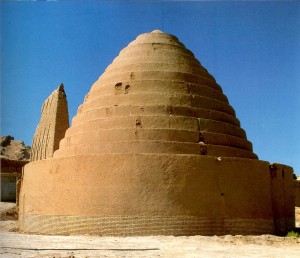Making ice without electricity

An ice house in Iran - Image from Gardens of Persia, Penelope Hobhouse, photo by Jerry Harpur, published by Floriligium (yes, the same wonderful gardening bookshop in Glebe)
Four hundred or so years ago Persian engineers made ice without electricity.
Ice houses (yakhchal in Farsi, or icehouse) kept ice in the burning heat of the Iran plateau. They’re rarely used today.
They’re up to 20 metres high and 6 or so metres below ground. A single door is insulated with thick, dry grass. Thick walls, 2 metres at the base, and their shape – an inverted funnel which allows cooling wind to spiral down the exterior – keep the ice frozen for the summer. The walls are made of sand, clay, egg white, lime, ash and goat hair. During the winter there are shallow ponds with high walls on the sunny side which are filled with water which becomes ice. Thus, Persian wealthier classes ate ice cream several centuries ago without electricity.
Thanks to the author of this book for the text: Two wings of a nightingale – Persian soul, Islamic heart by Jill Worrall, on the road in Iran, Exiles Publishing 2011 P 68


Hi Michael,
Great stuff, It never ceases to amaze me how society is willing continually evolve at the expense of the environment. As this article shows we could all still live comfortably and still have the luxury of ICE with a few small changes to our behaviors Hats off to the Persians for such a creative solution to a problem they faced many moons ago. .